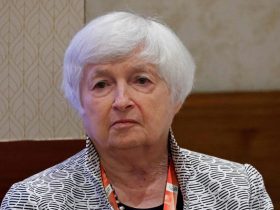“ Be cautious about relying on historical parallels. ”
In investment management, past performance is no guarantee of future returns. In economics, we’ve seen many predictions of a U.S. recession that so far, at least, have not materialized. Investors should take note that the past performance of a key economic tenet — that a recession follows an inverted yield curve — may no longer be as reliable today as it once was.
Let’s first look back at the pace of inflation. When it started to ramp higher in 2021, many economists, as well as the Federal Reserve, dismissed the pattern as “transitory.” But by March 2022, the Fed understood that the new inflation pattern was serious and commenced raising short-term rates. That November, the Fed’s guidance hardened, with Fed Chair Jerome Powell stating that “reducing inflation is likely to require a sustained period of below-trend growth and some softening of labor market conditions.”
At this point, the U.S. Treasury two-year yield
BX:TMUBMUSD02Y
was higher than the 10-year yield
BX:TMUBMUSD10Y,
creating an inverted yield curve, and rates were rising at the most rapid pace since the early 1980s. For the vast majority of economists, these facts were strong signals to forecast rising unemployment and a U.S. recession in 2023.
Yet as the fourth quarter of 2023 approaches, signs of a U.S. recession are not so clear. The consensus of many economists has shifted away from the recession forecast, although some have merely pushed the timing into 2024, citing lags in monetary policy, or shifted to words like “mild” or “soft landing” to describe any possible future downturn.
Yield-curve indicator breaks down
Why the shift? Regardless of whether we eventually end up in a recession, the key here is how an inverted yield curve may not mean the same as it did 20 years ago. Has our economy become far more resilient in the face of restrictive interest rate policies?
Let’s look at what history shows us. Back in the 1950s, ’60s and ’70s, manufacturing was the engine of the U.S. economy, with the purchase of durable goods often facilitated by credit. If one wanted to buy a house, a 30-year fixed-rate mortgage was the only choice. Moreover, that choice was typically provided by a savings and loan institution that borrowed short-term from savers and lent long-term for houses or medium-term for cars.
Taking interest-rate risk and surviving short periods of inverted yield curves was the savings and loan business model, since efficient rate hedging vehicles were not available. When the Fed hiked interest rates, lending slowed for houses and cars, the economy slumped, and unemployment eventually started to rise.
Fast forward to today. The U.S. is a service-sector economy, and most service purchases do not involve a loan or credit. Mortgages come in all shapes, sizes, terms and maturities, and are originated by specialized brokers that package and sell the mortgages to investors who want to hold this risk. For financial institutions, the ability to hedge and manage interest-rate risk is further supported by deep markets in swaps, futures and options.
Higher rates, which alter the time value of money, still have a profound impact on asset markets, from equities to fixed income. But the impact of those rates on the real economy is much less clear as the U.S. economy evolves. Yet, most econometric models still rely on historic relationships, which don’t take into account recent structural changes impacting interest-rate sensitivity.
Moreover, the last three serious recessions all required something big and systematic to break. In 1991, it was the savings and loan industry and the housing market, brought on by tighter credit conditions. In 2008, it was the financial crisis brought on by risk taking in subprime housing. In 2020, it was the Covid-19 pandemic, which had nothing to do with rates.
This year, the failure of a few niche regional banks could have been the trigger for contagion and a serious banking system collapse. That was not the case because regulators quickly backstopped the system. Additionally, most banks had hedged their positions.
Could it be that a less interest-rate sensitive economy and a regulatory network committed to preventing systemic financial-system breakdowns has reduced the power of an inverted yield curve to forecast a recession? Time will tell. Until then, investors should be cautious about relying on historical parallels as they prepare their portfolios for the risks ahead.
Blu Putnam is chief economist at CME Group. The research views expressed are those of the author and do not necessarily represent the views of CME Group or its affiliates.
More: See how much inflation has raised your cost of living.
Also read: ‘Complicated’ inflation report leaves U.S. stocks mixed, keeps higher-for-longer theme in rates intact
Read the full article here











Leave a Reply